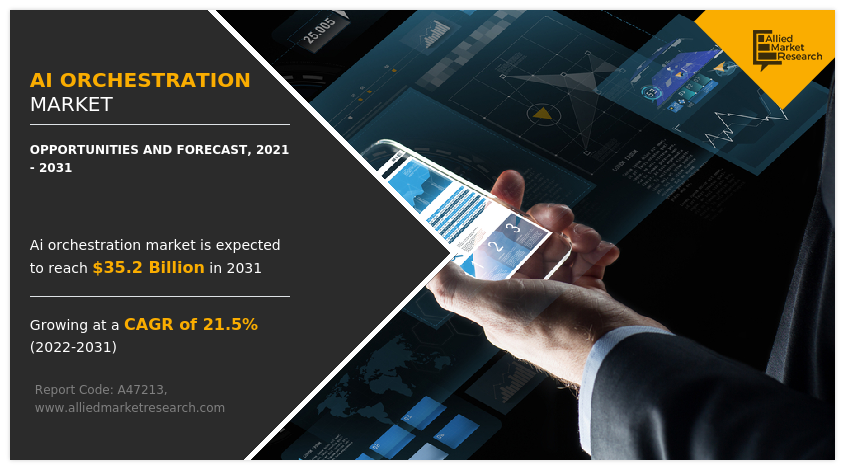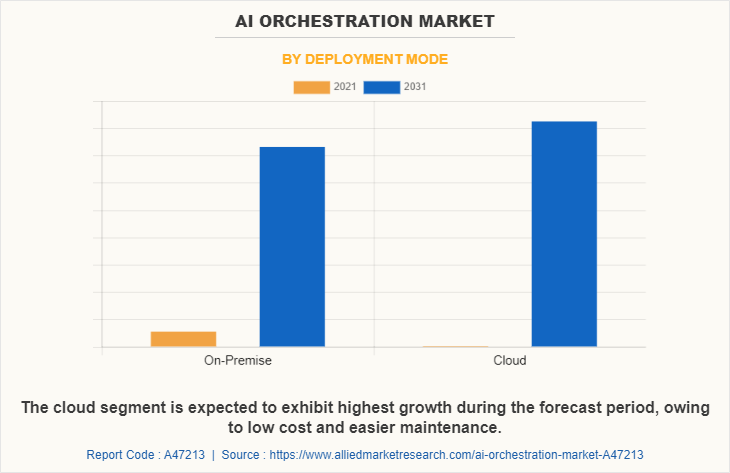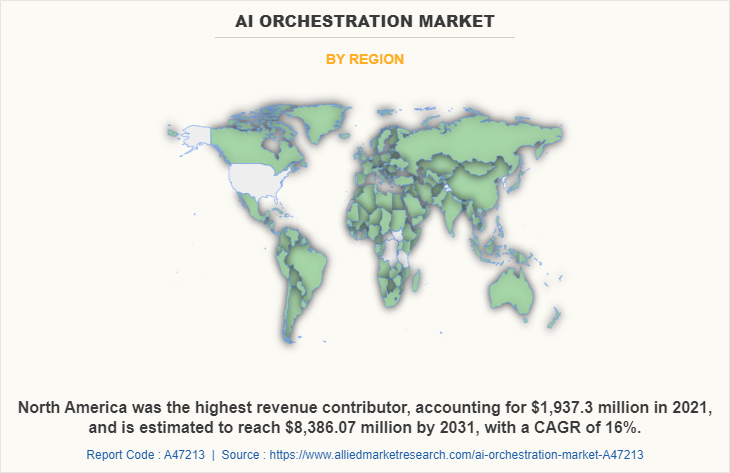AI Orchestration Market Statistics, 2031
The global AI orchestration market was valued at $5.2 billion in 2021, and is projected to reach $35.2 billion by 2031, growing at a CAGR of 21.5% from 2022 to 2031.
Moreover, AI orchestration offers multiple benefits including enabling IT teams to automate tasks across multiple platforms from a single point, which provides centralized monitoring and management over all IT servers, applications, and workflows. In addition, centralized coordination among IT servers and applications enables easier and faster integration of new tools and systems to the existing infrastructure. Furthermore, coordinating IT workflows such as DevOps and automation testing enables faster time to release new products and applications. Such benefits provide lucrative opportunities for the market growth during the forecast period.

An AI orchestration solution helps enterprises operationalize artificial intelligence (AI) enabling scalability and growth. Enabling technologies such as machine learning and AI assists with data preparation, model building and deployment, insight generation, and insight explanation to augment how enterprises explore and analyze the data. Furthermore, it accesses an automated machine learning environment that redefines enterprise AI by automating every step of the data life cycle including auto model building using simple workflows.
In addition, it allows to build and manage AI models in minutes without writing a single line of code. It helps to widen and democratizes AI to anyone across the organization as well as eliminating bias through explainable AI capabilities ensuring transparency and interpretability. Moreover, AI orchestration helps to visualize, analyze, and consume the enterprise complex data. It auto-visualizes the data and automatically uncovers hidden and crucial insights.
In addition, it creates charts, dashboards, and reports to understand and share business insights. It derives deep insights from real-time streaming data and consumes business insights through visualization. Further, it improves productivity and reduces infrastructure management time, enhancing innovation and growth across businesses through AI-driven decision analytics.The AI orchestration market is segmented into Component, Deployment Mode, Application, Organization Size and Industry Vertical.
Segment Review
The AI orchestration market is segmented into component, deployment mode, application, organization size, industry vertical, and region. By component, it is bifurcated into solution and services. By deployment mode, it is divided into on-premise and cloud. On the basis of application, it is categorized into workflow orchestration, customer service orchestration, infrastructure orchestration, manufacturing orchestration, and others. By organization size, the market is segmented into large enterprises and small and medium-sized enterprises. On the basis of industry vertical, the market is categorized into IT and telecommunications, manufacturing, healthcare, BFSI, consumer goods and retail, government and defense, energy and utilities, and others. Region wise, it is analyzed across North America, Europe, Asia-Pacific, and LAMEA.

On the basis of deployment mode, the on-premise segment captured the largest market share in 2021 and is expected to continue this trend throughout the forecast period. This is attributed due to the numerous advantages offered by on-premise deployment such as a high level of data security and safety. Industries prefer on-premise model owing to high data security and less data breach as compared to cloud based deployment models, which further drive the demand for on-premise deployment model within the sectors. However, cloud segment is expected to exhibit highest growth during the forecast period. Factors, such as rise in the adoption of cloud-based AI orchestration due to low cost and easier maintenance, drives the growth of the market.

Depending on the region, North America dominated the AI orchestration market share in 2021. This is due to the high concentration of artificial intelligence and cloud-based solution vendors in the region are anticipated to provide the lucrative growth opportunities for the AI orchestration market in this region. However, Asia-Pacific is expected to exhibit highest growth during the forecast period, owing to ongoing rapid digital transformation trends that are expected to increase the scope for AI orchestration industry in this region.
Top Impacting Factors -
Rising adoption of AI orchestration solution across several industry vertical:
Several industry verticals such as banking, financial services and insurance (BFSI), retail, healthcare, manufacturing, telecommunication & IT, energy & utilities, and others adopt AI orchestration solution & services at a rapid pace. In addition, the banking sector is keen to adopt AI orchestration due to benefits such as cost savings, optimum resource allocation, and streamlined business processes. Technological advancements in the IT sector and their applications in large enterprises and SMEs also create an adequate space for market development in the developed regions, including North America and Europe.
Moreover, sudden closures of offices, schools and businesses have increased demand for digitalization. The Work from Home (WFH) initiative has positively impacted the AI orchestration market in various vertical such as IT, telecom, BFSI, and healthcare. This increase in adoption of AI-based solution & services platforms is driving the AI orchestration market growth. For instance, in October 2021, IBM and Cisco collaborated to enable orchestration and management of 5G Networks. This collaboration will help customers with their digital transformation for over a quarter of a century. Such ongoing improvement unlock the newer advanced technologies such as 5G, and AI technologies, which is expected to propel the growth of the market during the forecast period.
Rise of responsible AI:
Artificial intelligence has transformed business management in the modern business environment by integrating workflow management tools and trend forecasting. This acts as the primary driver of the artificial intelligence market. In addition, increase in investment in artificial intelligence technology and machine learning notably contributes toward the market growth. With the accelerated adoption of AI in 2022, responsible AI will take a front and center place in the AI field. As countries implement national AI strategies, they will need to seriously consider the moral implications of AI, ensuring positive automation outcomes for all parties involved. Enterprises as well will need to create AI systems that explain the rationale behind their decisions and do not discriminate against ethnicity, age, gender, religion, or place of residence. In the upcoming era, all AI professionals will have to demonstrate a good grasp of responsible AI principles to secure a job.
Moreover, Forrester report predicts that the market for responsible AI solutions will double in 2022, as some regulated industries have started adopting responsible AI solutions that help companies turn AI principles such as fairness and transparency into consistent practices. Furthermore, the demand for these solutions extends to other industries and verticals deploying AI in their business. With the increase in adoption of responsible AI solutions, existing machine-learning vendors will acquire specialized responsible AI vendors for bias detection, interpretability, and model lineage capabilities, thus driving the AI orchestration market trends in the upcoming years.
Key Strategies Development/Key Initiatives:
- In October 2022, Oracle and NVIDIA announced a multi-year partnership to help customers solve business challenges with accelerated computing and AI. The collaboration aims to bring the full NVIDIA accelerated computing stack from GPUs to systems to software to Oracle Cloud Infrastructure (OCI).
- In October 2021, IBM and Cisco collaborated to help enable orchestration and management of 5G Networks. This collaboration will be helping customers with their digital transformation for over a quarter of a century.
- In September 2021, DISH Network Corporation selected IBM to help automate the U.S. first greenfield cloud-native 5G network. DISH's new smart network will be designed to be agile, scalable, and fully virtualized, benefitting enterprise customers across all industry verticals. DISH will leverage IBM's AI-powered automation and network orchestration software and services to bring broad 5G network orchestration to DISH's business and operations platforms.
- In August 2021, Wipro Limited, a leading global information technology, consulting, and business process services company announced a global strategic partnership with DataRobot, a leader in Augmented Intelligence. The partnership will deliver Augmented Intelligence at scale, to help customers become AI driven enterprises, and accelerate their business impact.
COVID-19 Impact Analysis
The current estimation of 2031 is projected to be higher than pre-COVID-19 estimates. The AI orchestration market has witnessed significant growth in the past few years, and is expected to further exhibit notable growth, due to outbreak of the COVID-19 pandemic. This is attributed to surge in need of artificial intelligence-based solution & services among enterprises for improving their customers’ needs and to upsurge their revenue opportunity. In addition, use of AI orchestration technologies for managing growing volume of data generated from various devices in an organization drives the growth of the market.
Furthermore, the increasing adoption of AI orchestration in various end-user industries such as E-commerce, education, automobiles, marketing, healthcare, and agriculture is expected to drive the growth of the AI orchestration market. In addition, increasing adoption of cloud-based services, big data, Internet of Things (IoT), and machine learning platforms is expected to fuel the growth of the AI orchestration market. AI orchestration helps in reduced operational expenses, hassle-free deployment, high scalability, easy data accessibility, and quicker access to crucial data, among others. Such few advantages is expected to provide lucrative growth opportunities for the market during the forecast period.
On the contrary, one of the most effective approaches for businesses is to transition from a labor force equipped with traditional systems to a workforce empowered by technology and talent such as an augmented workforce. They assist the workforce by providing predictive maintenance, informing ahead of time when machines will require servicing or repair. By integrating the existing workforce with AI, companies will be able to increase productivity while increasing safety and reducing equipment downtime. AI adoption will continue to contribute to business success by enabling a better understanding and servicing of customer demand and a faster response to their needs. AI will continue to transform the workplace, and workers will be required to engage in life-long learning and upskilling. Such major factors will propel the AI orchestration market forecast in the upcoming years.
In addition, while estimating the market size, AMR has considered the impact of COVID-19 on each country, and the estimated numbers are completely dependent on the current ongoing situation of COVID-19 in each country. However, there is still no clarity on the deeper impact that it is having across businesses, industrial sectors, and organizations, due to factors such as continuous increase in number of COVID-19 cases with different rate and changes in lockdown period.
Key Benefits for Stakeholders
- The study provides an in-depth AI orchestration market analysis along with the current trends and future estimations to elucidate the imminent investment pockets.
- Information about key drivers, restrains, and opportunities and their impact analysis on the AI orchestration market size is provided in the report.
- The Porter’s five forces analysis illustrates the potency of buyers and suppliers operating in the AI orchestration industry.
- The quantitative analysis of the global AI orchestration market for the period 2021–2031 is provided to determine the AI orchestration market potential.
AI Orchestration Market Report Highlights
| Aspects | Details |
| Market Size By 2031 | USD 35.2 billion |
| Growth Rate | CAGR of 21.5% |
| Forecast period | 2021 - 2031 |
| Report Pages | 309 |
| By Component |
|
| By Deployment Mode |
|
| By Application |
|
| By Organization Size |
|
| By Industry Vertical |
|
| By Region |
|
| Key Market Players | Capgemini Services SAS, General Electric Company, Cisco Systems, Inc., BMC Software, Inc., IBM Corporation, Fujitsu Limited, TIBCO Software Inc., Hewlett Packard Enterprise Company, Wipro Limited, Oracle Corporation |
Analyst Review
According to CXOs of the leading companies, over the time, businesses have seen various changes in the business processes, operations, and industrial automation. Moreover, businesses are shifting toward the digital platform and increasing implementation of Industry 4.0 to cope with ongoing tough business competition, which creates the need for seamless solution to meet these requirements. This increases eventually escalates the adoption of AI orchestration market. Furthermore, demand for AI-based systems has been increasing in the past few years and is expected to continue this trend in the coming years as well, owing to increasing market competitiveness and rising quality standards, which are enabling the development of AI-based applications that can automate business operations while maintaining quality and efficiency in due time.
Moreover, increasing application and accuracy of AI orchestration has increased its demand for government and public sector organizations to promote automation. In addition, owing to growing digital and internet penetration in many regions of the world promises new opportunities for the growth of the AI orchestration market.
Key providers of the market such as IBM Corporation, Wipro, and others accounted for a significant share in the market. With larger requirement from AI orchestration solution, various companies are establishing partnerships and product development to increase AI orchestration capabilities. For instance, with the introduction of its new AI-powered orchestration capability, Resulticks, the world’s fastest growing real-time conversation marketing solutions provider, has forever changed the game for how brands orchestrate outcomes-focused, omnichannel user experiences with the development of AI orchestration solution.
With a few clicks, marketers can initiate the auto-mapping of entire customer experiences based on key occasions, communication goal and type, product type, and benchmarks. Such an enhancement provides the lucrative opportunities for the market growth during the forecast period. Moreover, market players are expanding their business operations and customers by increasing their partnership and acquisition and other strategies. For instance, in October 2022, Oracle and NVIDIA announced a multi-year partnership to help customers solve business challenges with accelerated computing and AI. The collaboration aims to bring the full NVIDIA accelerated computing stack from GPUs to systems to software to Oracle Cloud Infrastructure (OCI).
The global AI orchestration market was valued is projected to reach $35,161.74 million by 2031.
Factors such as growing digitalization and internet penetration across the world is positively impacting the growth of the market.
The North America is the largest market for the AI Orchestration.
The key growth strategies for AI Orchestration include product portfolio expansion, acquisition, partnership, merger, and collaboration.
BMC Software, Inc., Capgemini Services SAS, Cisco Systems, Inc., Fujitsu Limited, General Electric Company, Hewlett Packard Enterprise Company, IBM Corporation, Oracle Corporation, TIBCO Software Inc., and Wipro Limited.
Loading Table Of Content...


